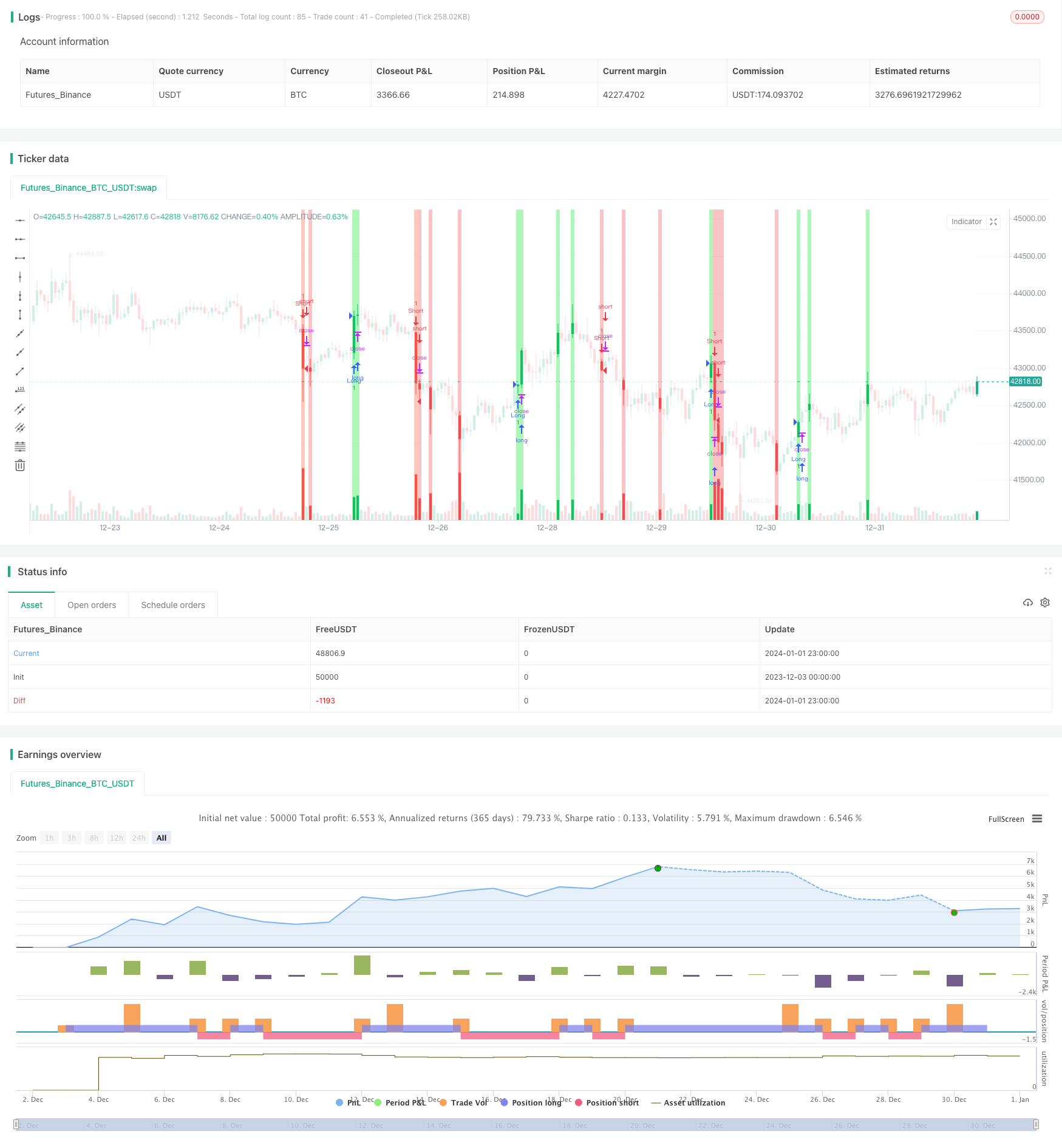
概述
该策略运用ATR通道和破口理论,在突破通道时踏入趋势,属于趋势跟踪策略。策略简单易懂,运用均线通道和ATR指标判断趋势方向,在关键点位发出交易信号。
策略原理
该策略使用高、低、收盘价和ATR指标构建上下轨,形成ATR通道。通道宽度决定于ATR参数的大小。当价格突破通道时,判断为趋势开始,此时进入做多或做空方向。策略分为两档交易信号,价格突破一个ATR宽度视为趋势初现,此时第一档买卖点被触发;价格突破两个ATR宽度则视为趋势加速,第二档买卖点被触发。
优势分析
该策略主要优势如下: 1. 采用ATR指标构建通道,考虑市场波动率,优于简单均线。 2. 两档买卖点设定,分批进入,风险可控。 3. 突破理论判断趋势,精准定位关键点位。 4. 代码精简,容易理解实施。
风险分析
该策略主要风险如下: 1. 单一指标判断,当ATR失效时,策略失效概率大。 2. 未设立止损限制和头寸管理,风险控制不足。 3. 效用待验证,实盘条件下可能效果欠佳。 4. 参数不合适可能导致穿越或过度交易。
优化方向
该策略可以优化的方向如下: 1. 增加多种指标过滤和确认,防止误判。 2. 增加止损模块,加强风险控制。 3. 增加仓位控制和头寸管理。 4. 增加参数优化,针对不同品种参数调整。 5. 减少交易频率和仓位规模,考虑实盘条件。
总结
该策略整体框架清晰,作为概念验证策略可以理解使用。但距离实盘还存在一定差距,有较大优化空间。如果能进一步完善风控和交易频率控制,则该策略应用前景较好。
策略源码
/*backtest
start: 2023-12-03 00:00:00
end: 2024-01-02 00:00:00
period: 1h
basePeriod: 15m
exchanges: [{"eid":"Futures_Binance","currency":"BTC_USDT"}]
*/
// This Pine Script™ code is subject to the terms of the Mozilla Public License 2.0 at https://mozilla.org/MPL/2.0/
// © Myhaj_Lito
//@version=5
strategy("Renko Trend Strategy",shorttitle = "RENKO-Trend str.",overlay = true)
TF = input.timeframe(title='TimeFrame', defval="60")
ATRlength = input.int(title="ATR length", defval=60, minval=2, maxval=1000)
HIGH = request.security(syminfo.tickerid, TF, high)
LOW = request.security(syminfo.tickerid, TF, low)
CLOSE = request.security(syminfo.tickerid, TF, close)
ATR = request.security(syminfo.tickerid, TF, ta.atr(ATRlength))
RENKOUP = float(na)
RENKODN = float(na)
H = float(na)
COLOR = color(na)
BUY = int(na)
SELL = int(na)
UP = bool(na)
DN = bool(na)
CHANGE = bool(na)
RENKOUP := na(RENKOUP[1]) ? (HIGH + LOW) / 2 + ATR / 2 : RENKOUP[1]
RENKODN := na(RENKOUP[1]) ? (HIGH + LOW) / 2 - ATR / 2 : RENKODN[1]
H := na(RENKOUP[1]) or na(RENKODN[1]) ? RENKOUP - RENKODN : RENKOUP[1] - RENKODN[1]
COLOR := na(COLOR[1]) ? color.white : COLOR[1]
BUY := na(BUY[1]) ? 0 : BUY[1]
SELL := na(SELL[1]) ? 0 : SELL[1]
UP := false
DN := false
CHANGE := false
// calculating
if not CHANGE and close >= RENKOUP[1] + H * 2
CHANGE := true
UP := true
RENKOUP := RENKOUP[1] + ATR * 2
RENKODN := RENKOUP[1] + ATR
COLOR := color.rgb(0, 255, 170,60)
SELL := 0
BUY += 2
BUY
if not CHANGE and close >= RENKOUP[1] + H
CHANGE := true
UP := true
RENKOUP := RENKOUP[1] + ATR
RENKODN := RENKOUP[1]
COLOR := color.rgb(0, 230, 38,60)
SELL := 0
BUY += 1
BUY
if not CHANGE and close <= RENKODN[1] - H * 2
CHANGE := true
DN := true
RENKODN := RENKODN[1] - ATR * 2
RENKOUP := RENKODN[1] - ATR
COLOR := color.rgb(255, 92, 43,60)
BUY := 0
SELL += 2
SELL
if not CHANGE and close <= RENKODN[1] - H
CHANGE := true
DN := true
RENKODN := RENKODN[1] - ATR
RENKOUP := RENKODN[1]
COLOR := color.rgb(245, 69, 69,60)
BUY := 0
SELL += 1
SELL
//// STRATEGY
if(UP)
strategy.entry("Long",strategy.long)
if(DN)
strategy.entry("Short",strategy.short)
// ploting
bgcolor(COLOR)